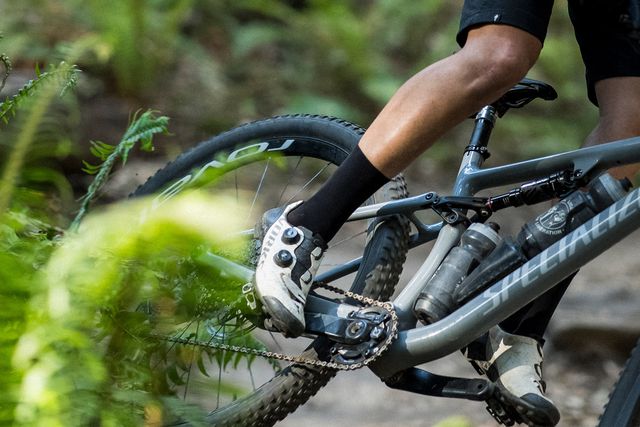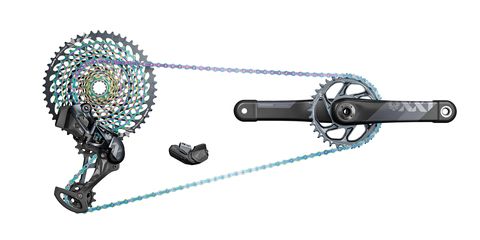Less than a decade ago the 1x drivetrain — a single front chainring with a large rear cassette — was an outlier, found primarily on homemade franken-bikes. Since the advent of the front derailleur in the 1930s, most bikes have employed dual mechanisms — typically two chainrings in front and several in back — providing a wider range of gears and smaller gaps between them.
For nearly a century, 1x groupsets lived on the fringe, limited by their range. Considered inefficient and slow, they were a black sheep in the bike world. But with new technology emerging, that reputation is going out the window.
In 2012, SRAM boldly announced the “death of the front derailleur” with the first mass-produced 1x groupset, designed for mountain bikes. Although the claim was a bit premature, it wasn’t completely wrong. The new 1x system came with an 11-cog rear cassette the size of a dinner plate, providing the same high and low gears as most double-chainring mountain bikes, without front shifting.
“The main selling point was simplicity and the freedom it gave the rider,” explains Chris Mandell, SRAM’s North American PR manager. “We’re all human beings, getting on bikes, trying to interface with the terrain. From beginners to elite athletes it’s the same challenge on the trail. The one-by system frees up headspace to focus on riding and reduces boundaries between you and the trail.”
Despite early pushback, the 1x became industry standard for mountain bikes within a few years. Today it’s rare to see anything but 1x drivetrains on the trail, as every major bike manufacturer designs specifically for them. On most bikes, dropper post levers now occupy the space where a second shifter used to live, making them ergonomic and easier to use. With this foothold, the movement to simplify drivetrains started to grow.
“As mixed-terrain riding started to explode a handful of years ago, demand for components that perform better on multiple surfaces followed suit,” says Elliott Lane, USA road & gravel category leader at Specialized Bicycles. “In the US, the gravel market has grown over forty percent year over year, and these riders are taking their bikes on gravel roads, double track, even single-track mountain bike trails. They’re facing bumpier and steeper terrain, and one-by drivetrains often perform better in these situations.”
In 2016, SRAM unveiled a 12-speed rear cassette for the 1x system, mitigating most of the range problem. The original Eagle had a 500 percent gear range – the difference between the largest and smallest gears – and a massive granny gear, offering a larger range than many two-by setups. By emphasizing durability and user-friendly shifting, the Eagle broke into the drop-bar world and soon started to dominate the adventure and gravel categories.
“Our goal was never to blow the doors off,” notes Mandell. “We wanted to listen to riders about their needs and build a system that was right for them. This was primarily focused on a larger range and an easier gear to go up hills. We were hearing this from everyone — everyday consumers to pro athletes. People want to conserve energy on the up to be safer and have more fun on the way down.”
By 2016, 1x drivetrains were widely available for gravel and road bikes, encouraging bike manufacturers to design frames specifically for them. To many makers, ditching that front derailleur provided more versatility and freedom.
“We adopted one-by groupsets for gravel bikes pretty early on, soon after the components were introduced four years ago,” recalls Stewart Thompson, global road & gravel category leader at Specialized. “Internally, most of our product team and testers prefer one-by drivetrains and so the changes to our bikes have followed a logical progression. While designing solely for one-by removes some variables and allows for larger tires, we wanted to retain two-by compatibility and give multiple options to the rider.”
For many riders, the advantages of a 1x soon became worth the swap. The shifting is simple, the chain falls off less, and a couple hundred grams of weight is shaved off your bike. Plus, with fewer parts, 1x drivetrains cut down on mechanical issues — and they’ll eventually be less expensive, too.
“We launched the new Eagle with 52 teeth,” says Mandell. “It’s a combination of many small tweaks to shifting and durability that make the system much better. This cassette paired with the right chainring will roll fast on flats and really help on long, steep climbs too.”
While it’s too early to tell if the GX Eagle will finally close the range gap and be adopted by the skinny tire world like its counterparts on gravel and mountain bikes, it’s certainly possible that we see a 1x groupset in the peloton of a pro race in the near future.

















